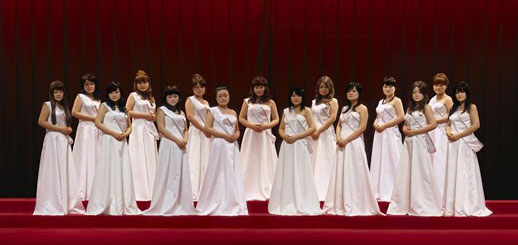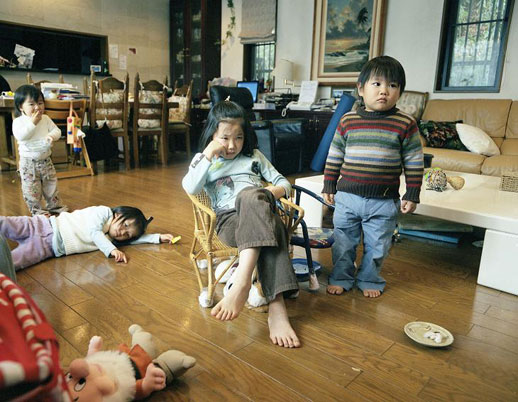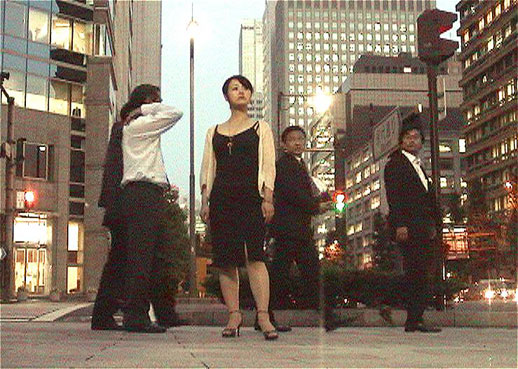Bodies of Portraiture
“On Your Body”, the title of this exhibition, is an ambiguous phrase. However it immediately places the audience under a semantic lens: my body? our bodies?… we find ourselves wondering as we take in the diverse work of six Japanese photographers. All the photographers are women, and their work, while certainly diverse, strays little from ‘portraiture’, yet nowhere are these points of commonality engaged with at the curatorial level — instead, says the sign at the door, these works are about “the body” and the “now” in contemporary Japan.

There are some levels on which the bounds of photography itself seem to have become conceptually very loose, or perhaps questioned by the curators. Shizuka Yokomizo, for example, presents a simple and poignant two-channel video projection: on one wall, four elderly women play the same tranquil piece of Chopin at the piano in their homes; on the adjacent wall, the camera has been fixed on the amateur pianists’ ‘habitus’, their home or garden. The different approaches of each of the women reveals the individual expression of the “same” piece of music. Yet, after a while the pace of the video conveys a forced sense of poignancy and slowness, and I couldn’t help wondering what the women were really thinking while playing Chopin, trying to look so old, wise and pensive.
Without wanting to invest too much in semantics, the reality of the exhibition seems at odd with its press release, which presents it as an “exhibition of Japanese emerging artists” — which feels rather different to saying ‘contemporary photography’. I wondered what it meant to describe these artists as ‘emerging’, considering that most have published photo-books, won major Japanese photography prizes, relocated overseas or shown in international exhibitions (such as Tomoko Sawada in “Heavy Light” at the International Center of Photography in New York this spring, or the Shizuka Yokomizo at the Tate Triennial in 2003, for example). And all this over a period of five to ten years, if not longer.
Lieko Shiga may be the youngest and most ‘emerging’ artist of the six, but her work — comprised of two series, ‘Lilly’ and ‘Canary’ — has the most conceptual and technical allure, even if ‘Lilly’ has been on show only recently in ‘Trace Elements’ at Tokyo Opera City Art Gallery.
On the other hand, the only interesting aspect to the inclusion of Tomoko Sawada’s ‘self-portraits’ in the show is that the curators could consider her work ‘emerging’ or reflective of the ‘now’ in Japanese photography. Having leaped to stardom with every major Japanese photo prize, with a professorship to boot, Sawada relocated to New York last year. I couldn’t help wondering if this work would seem more ‘now’ over there. Her take on the generic nature of female ‘beauty’ in Japan seems to stop at the doors of soapland chic, without a truly engaging sense of reflexivity. In a country where the Women’s Fashion section of clothing stores have an apron section, where even a purikura mini sticker photo booth brings up identity and gender issues, Sawada’s monotonous approach to self-portraiture, despite being buttressed by Photoshop magic and state-of-the-art printing techniques, seems somehow out of time with the social issues she attempts to critique.
Yumiko Shiozaki’s work remains a version of the ‘snapshot’ genre that came to prominence with the autobiographical styles of young female photographers from the late 1990s, though here executed with real poignancy and tangible intimacy for her subject, also an elderly (non-Japanese) woman. This snapshot genre, however, seems to necessitate positing one’s surrounding as a strange alien landscape; while some may consider the camera’s point of view less monocular and objectifying that the history of what some consider a singularly male gaze, the lens becomes like a breathing apparatus necessary for exploration of this strange ‘new world’, and the photographer’s presence, while becoming the underlying subject of the entire genre, abrogates the critical responsibility attendant to such subjectivity. In other words, we are supposed to accept that these images are taken too ‘unconsciously’ and off the cuff to necessitate greater reflexivity.

Yoko Asakai’s work plays on the ‘seeing and being seen’ concept, the series on display depicts people who are ostensibly watching television. Again, the subjectivity of the photographer — who in this series has essentially become the television that is being watched — seems less important than the looks on her subjects’ faces, and the subsequent game of comparing their faces with the titles of movies they were watching — Psycho or All about Eve — leads to the surprising realization that although the photographer has captured such an eclectic bunch of people watching such different films at different times of day and in different places, their faces all show the same expression of impassivity.

Finally, leaving aside her three-screen video installation, Junko Takahashi has presented a series of straight portraits of female employees of large Japanese companies. The initial portraits have been re-photographed through a layer of clear acrylic cubes, giving her subjects a fractured or caged feel. However, using this device, in her words, to “symbolize the various elements between people” seems only to emphasize that each subject’s dilemma may be the same, rather than drawing out individual concerns to counter the monotony of the office environments in which they have been photographed.
One issue that recurs throughout the works was that while the camera is focused on ‘others’, it is still very much preoccupied with the photographers’ personal dilemmas about being women, about time passing between people, between environments we call ‘home’ and those that we do not; not to mention the way women respond to prescribed social models of femininity and how one ‘fits’ in with them. Trying to make such diverse works relate simply to ‘body-ness’ and ‘now-ness’ in Japan, seemed particularly difficult without articulating gender as a part of the exhibition’s curatorial concept, and without any recognition that so many of the featured artists are living in, or responding to, environments and relationships overseas. While there were certainly a number of interesting encounters that lingered with me after leaving the museum, there was neither the conceptual rigor, nor the genuine shock of freshness to pull these pieces together as a whole.
Olivier Krischer
Olivier Krischer


